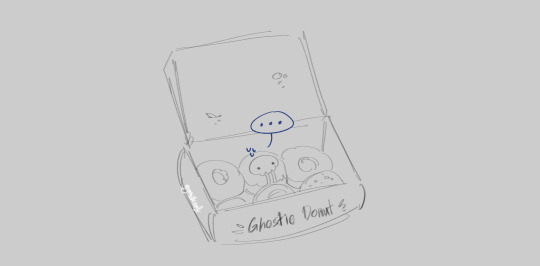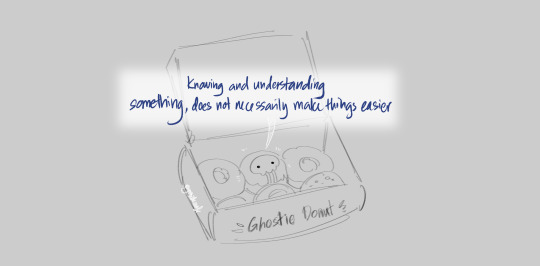#a hard pill to swallow for me personally as someone who intellectualize feelings a lot
Text
Ghost In a Box 003


#a hard pill to swallow for me personally as someone who intellectualize feelings a lot#Understanding may provide insight - but it does not always offer absolution#it could also be something like the paradox of knowledge in general#the more we know - the more we realize how much we don't know - and the cycles goes on#thats why there's the saying of ignorant is bliss#anyways this time I put him in a donut box cuz i thought that's cute#scheduled post#monday post#ghost in a box#gummmyart#doodle#simon ghost riley#simon riley#ghost cod#ghost call of duty#gummmyspeaks
245 notes
·
View notes
Text
Did My Client Make Progress?
So I have recently acquired 2 new interestingly different clients. The first one is an old lady in her 70s. She is old fashioned, very lovely, open and sarcastic. The second lady is in her middle adulthood. She is modern and calm. Their environment is also different as well. The old lady resides in the township while the other one in the suburbs.
Occupational therapy sessions must be client- centered (Snograss, J 2011). Furthermore, OTs have to treats around the client’s specific needs. That is why when you meet the client you conduct an interview where you ask very personal questions. Also, you involve the client in the intervention plan by asking their goals. In that way both your goals as an OT and a client can be met. Since we use activities to treat, that particular activity has to be applicable to your client for the intervention to be effective. For instance, if your client would like to be able to dress themselves independently, you have to work towards that goal. Whether by improving client factors or introducing new adaptive methods. What I have learnt is that most of the times clients may not understand the theory behind OT treatment methods. I have to find ways to explain to them the rationale. Otherwise they will feel as if you are wasting their time and not cooperate.
‘The goal of clinical reasoning is to decide on a treatment recommendation that is made in the best interest of a particular patient’ (Barbra, A 1993 pg 606). This is acquired by knowing your client very well- limitations, current abilities and what can be done to improve function. For every session the therapist must have a clear understanding and of the person’s condition and abilities. What helps me is every time a treatment idea comes up, right after I asked myself, ‘WHY?’. Why am I choosing this activity for my client and how is it going to help him regain or improve his function. If I am able to answer that while planning, it helps me answer the client when he asks the same question. If I confidently know, I gain the client’s trust and helps him to cooperate in the treatment session. What I have noticed is that clients question the way OTs treat as they are used to the exercise and gym methods only.
With that being said adherence is also very essential in treatment. As they say, you can take the horse to the water, but if it does not want to drink it won’t. That is why it is important for treatment sessions to be client centered and to have a good clinical reasoning. Also, to be able to explain to your client the aim of the session. Since I am in an acute setting adherence is important so that when I am not there as a therapist and the client has been discharged, he or she will be able to carry out the tasks on her own. If not than it would be a waste of both our times. This reminds me of the old lady when we were doing upper limb dressing. When I asked her if she will be able to apply the technique at home she teasingly said to me, I will take you with me so you can do it for it is fine.
With the old lady it is very hard to make a difference in her physical level of functioning as I have said before that she is old fashioned and old. She believes from her young age she has been taking care of everyone and now it is time for her family and neighbours to return the favour. She would rather cycle the whole day than to learn on improving her ADLs to be more independent. There is conflict between my goals for her as a therapist and her goals. She only wants to exercise to pass time during her stay at the facility and as an OT student I am unfortunately not allowed to do so. She would tell me she has daughter in laws, neighbours and children who are willing to help her. Basically, in my culture we are obligated to take care of our elderly especially the daughter in laws in sickness and in health. Anciently it was like you are married to the whole family. But I have never met someone who has opportunity to be independent in some areas especially in ADLs and choose not to. She told me straight in the face that she would rather be cycling the whole day than to be taught how to dress herself.

My second modern middle age client who I have seen for only two sessions has improved. On Monday we did lower limb dressing. I taught her gathering and dressing in long sitting and she has learnt very quickly and was able to do it by herself. She is very motivated to be independent again. She even told me she was going to ask nurses if she can now dress her pants all by herself. She also did not have good intellectual insight on her diagnosis. I printed a few articles for her and now she is more empowered. It is also very easy to explain the purpose of activities to her as she easily understands.
This block has been quite a roller-coaster: different clients with different expectations, backgrounds and energy. I learnt a lot from my supervisor, MDT team of the hospital and my peers. To have clients notice that you are not there on a Wednesday and asking with concern (due academic suspension) was such an honour. it shows I made some difference in someone’s life. Also to have a client that sees you as a nuisance is quite a hard pill to swallow. I believe there is still a huge room for improvement and I am capable of becoming a competence Occupational therapist, “adding life to days”💕💕💕

Barbara A et al (1993). Clinical Reasoning in Occupational Therapy: An Integrative Review. 47(7), 605-609. Retrieved from http://ajot.aota.org on 04/03/2019 Terms of use: http://AOTA.org/terms
Images retrieved from: https://aohoshiart.tumblr.com/post/167735724953/a-little-late-but-i-just-have-so-many-feelings-for
Images retrieved from:https://www.highlandernews.org/22382/a-confused-face-is-a-great-meme/
Snodgrass J (2011). Effective occupational therapy interventions in the rehabilitation of individuals with work-related low back injuries and illnesses: a systematic review. 65(1):37-43 Retrieved from: https://www.ncbi.nlm.nih.gov/pubmed/21309370
0 notes